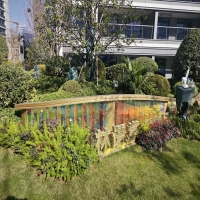Welcome to the website for landscape facilities products and knowledge.
What are the psychological benefits of using a round table in collaborative or social settings?
In the realm of collaborative and social environments, the simple round table holds profound psychological power that often goes unnoticed. Unlike rectangular tables that inherently create hierarchies with their "head" positions, circular seating arrangements eliminate visible power structures, fostering an immediate sense of equality among participants. This subtle architectural choice significantly impacts how we communicate, collaborate, and connect with others.
The psychological benefits begin with eye contact. Circular seating naturally allows all participants to maintain visual connection with each member of the group, creating what psychologists call "shared attention." This uninterrupted sightline promotes active listening and engagement, as no one is physically excluded from the collective gaze. Research in environmental psychology suggests this visual accessibility increases participation rates by up to 30% compared to traditional rectangular setups.
Furthermore, round tables democratize conversation. Without corners or clear power positions, speaking turns become more evenly distributed. Studies of meeting dynamics reveal that circular arrangements reduce conversational dominance by individuals in authority positions, allowing quieter members to contribute more freely. This creates what social psychologists term "psychological safety" - the belief that one can speak without fear of embarrassment or rejection.
The circular form also embodies powerful symbolic meaning across cultures. From King Arthur's legendary Round Table to traditional family gatherings, the circle represents unity, wholeness, and inclusion. This symbolism translates into tangible psychological effects, triggering what anthropologists call "circle consciousness" - the innate human understanding that circular formations promote fairness and collective purpose.
In therapeutic settings, round tables have demonstrated remarkable effectiveness in group therapy sessions. The configuration reduces defensive posturing and encourages vulnerability, as clients feel equally exposed and protected within the circular arrangement. Family therapists particularly value how round tables help redistribute family dynamics during sessions, temporarily neutralizing established power structures.
The neuroscience behind this phenomenon points to our brain's preference for symmetrical, balanced environments. Functional MRI studies show that people in circular arrangements display increased activity in brain regions associated with social connection and empathy. Meanwhile, rectangular setups often trigger subtle threat responses in our amygdala when individuals are seated at the "foot" of the table.
Modern workplace design has begun leveraging these psychological advantages. Tech companies and innovative organizations are increasingly incorporating circular meeting spaces to enhance creativity and collaboration. The results include more innovative brainstorming sessions, improved conflict resolution, and stronger team cohesion.
Even in educational contexts, circular classroom arrangements have shown significant benefits. Students demonstrate higher retention rates and increased participation when seated in circles, as the format encourages dialogue rather than passive reception of information from a single authority figure at the front.
The psychological impact extends beyond formal settings to social gatherings. Dinner parties around round tables often feature more lively, inclusive conversations where guests feel equally valued. This simple geometrical choice can transform the entire social dynamic of an evening, creating memories of connection rather than isolation.
As we continue to understand the profound relationship between spatial design and human psychology, the humble round table emerges as a powerful tool for fostering healthier, more productive, and more equitable social interactions in both professional and personal contexts.
Related search:

Recommendation
Metal and acrylic color-changing combined curtain wall for large-scale public landscape facilities